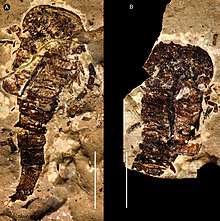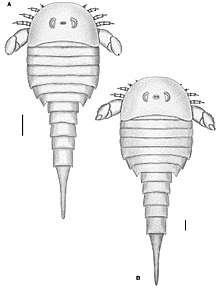Strobilopterus
Strobilopterus is a genus of prehistoric eurypterid of the family Strobilopteridae. The genus contains four species, two from the Devonian of Wyoming, United States (S. princetonii and S. proteus), one from the Devonian of Ohio, United States (S. richardsoni) and one from the Silurian of Estonia (S. laticeps).[1]
| Strobilopterus | |
|---|---|
 | |
| Fossil of S. proteus (left) with its counterpart (right) | |
| Scientific classification | |
| Kingdom: | Animalia |
| Phylum: | Arthropoda |
| Subphylum: | Chelicerata |
| Order: | †Eurypterida |
| Family: | †Strobilopteridae |
| Genus: | †Strobilopterus Ruedemann, 1935 |
| Type species | |
| Strobilopterus princetonii Ruedemann, 1934 | |
| Other species | |
| |
| Synonyms | |
| |
Description

Strobilopterus was a large strobilopterid eurypterid, with adults of the species S. proteus measuring approximately 15 to 20 centimetres in length.[2] The carapace of Strobilopterus was wide and semicircular in shape, with the lateral eyes lunate to crescentic with the palpebral lobe between the central and centrimesial sectors. The first pair of appendages were small, lacking denticles, and the subsequent four pairs of appendages were likewise also small, but with fixed spines and serrated distal podomere margins. The sixth and last pair of appendages were short but were powerfully serrated on the anterior margins of the podomeres. The type A genital appendage was long and undivided, the type B appendage was more oval in shape.[2]
References
- Dunlop, J. A., Penney, D. & Jekel, D. 2015. A summary list of fossil spiders and their relatives. In World Spider Catalog. Natural History Museum Bern, online at http://wsc.nmbe.ch, version 16.0 http://www.wsc.nmbe.ch/resources/fossils/Fossils16.0.pdf (PDF).
- Lamsdell JC, Selden PA (May 2013). "Babes in the wood--a unique window into sea scorpion ontogeny". BMC Evolutionary Biology. 13: 98. doi:10.1186/1471-2148-13-98. PMC 3679797. PMID 23663507.
